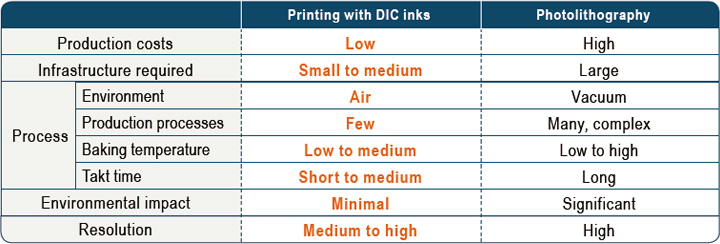Special Feature Printed Electronics : Materials for Printed Electronics
Making today’s advanced information society easier to navigate and more environment-friendly
Social Imperative Simplify patterning processes for electronic circuits to reduce consumption of resources and energy and production costs
Electronic circuits are the heart of sophisticated electronics equipment and electrical appliances that make our lives more convenient and comfortable. The process most commonly used to form patterns on electronic circuits is photolithography, which basically involves protecting selected areas of a functional layer that has been deposited on a substrate and chemically removing unnecessary areas. Nonetheless, photolithography has a number of downsides, notably the fact that it is a multistage process requiring substantial capital investment, uses significant volumes of raw materials—including rare metals—and energy, and emits substances that negatively affect the environment.
Considerations such as these have prompted great interest in printed electronics, a next-generation technology that uses printing technologies and boasts a number of benefits not available with photolithography. Unlike the photolithographic process, which requires coating the surface of the substrate with a protective layer (resist), pattern exposure, development etching and the stripping off of unnecessary portions of the functional layer, printed electronics require only printing equipment and inks, which greatly simplifies patterning and enables low-temperature baking, thus allowing the use of pattern flexible substrates. Moreover, printed electronics minimize facility needs and energy consumption as well as the emission of environmentally damaging substances during patterning.
DIC’s Response Develop inks for printed electronics that deliver high resolution and facilitate low-temperature baking
Printing circuit patterns demands conductive inks that deliver high resolution. Quality determines the reliability of a circuit or device. DIC has leveraged its proprietary dispersion technologies to develop inks for printed electronics using gravure printing, inkjet printing (which involves propelling droplets of ink onto the print substrate) or reverse offset printing to facilitate line widths as fine as 5.0 µm.
Of particular note, DIC has also developed a nanosilver dispersion (ultrafine—i.e., 10–30 nm—particles of silver dispersed in a solution) and electroconductive ink made with evenly and precisely dispersed micrometer-sized silver particle which, when used together, deliver excellent electroconductivity and adhesion to substrates.
Because these inks facilitate low baking temperature, they can be used to print patterns on substrates made of plastics and other materials that are less resistant to heat. Potential applications for these inks are diverse and include electronic paper, displays, solar cells and organic thin-film transistors (TFTs)*.
- Organic TFTs—thin transistors that use organic semiconductors for the active layer—are under development with the aim of facilitating the low-cost production of large electronics products.
DIC’s inks for printed electronics were awarded an Outstanding Achievement Prize at FPD International 2013 (Yokohama, Japan)
KEY PERSON of DIC
We are driving change by capitalizing on DIC’s innovative materials technologies and printing ink design capabilities.

Our inks for printed electronics were made possible by the integration of DIC’s raw materials technologies, compounding technologies—which determine the properties of ink—and mass production technologies. However, there are numerous key factors besides conductive inks that need to be considered in printed electronics, including insulators and semiconductors, meaning that it is crucial for us to take into account overall systems. We look forward to capitalizing further on our design capabilities for materials and printing inks and our expertise in matching inks to printing equipment needs to contribute to the realization of next-generation technologies for printed electronics.
Head Researcher, PE Development Group, Core Value Research Center, Corporate R&D Div. Hirotomo Sasaki
We are accelerating technological innovation by leveraging DIC’s proprietary printing inks technologies, as well as by promoting broad collaboration.

Inks for printed electronics facilitate finer patterning and low-temperature baking. The latent market potential for these inks is thus immeasurable. Because such inks will facilitate not only increased degrees of integration and a shift from glass to film substrates but also uniform, highly precise patterning even on large substrates, it is possible that they may fundamentally alter the look of electronics equipment. However, for printed electronics to replace photolithography, technological innovation in printing equipment, among others, is crucial. With the aim of driving progress in printed electronics, and of encouraging broad market acceptance, we are promoting a variety of efforts to accelerate innovation, including collaborating with other manufacturers in related areas.
General Manager, High-Performance Chemicals Development and Sales Dept., Advanced Polymer Sales Div. Hiroshi Isozumi
Special Topics 2014

Ceranate® : Hybrid Resin for Coatings
Seeking to shield houses and other structures from UV rays and air pollution

Hybranch® : Hyperbranched Polystyrene
Enhancing the environmental performance of food containers, electrical appliance components and insulating materials

Solar Cells : Materials for Solar Cells
Seeking to extend the lives of solar cell modules

Lithium Ion Batteries : Materials for Lithium-Ion Batteries
Contributing to the evolution of high-performance batteries is essential in a smart technology-based society

Printed Electronics : Materials for Printed Electronics
Making today’s advanced information society easier to navigate and more environment-friendly
TOPICS
Sun Chemical Revamps its Website
The Sun Chemical Group, a core member of the DIC Group with operations in North America and Europe, recently revamped its website, improving search capability and simplifying navigation.
DIC Expands Supply Capabilities for Linablue® Natural Blue Food Coloring
Rising concern for the health benefits and safety of food is accelerating a shift toward using natural, rather than synthetic, colorings in the food products industry. As the world’s largest manufacturer of one of the few natural blue colorants in existence, the DIC Group intends to bolster its supply capabilities by building a new plant in the United States.






